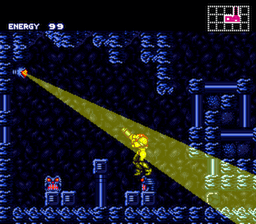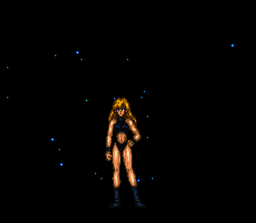
Let us bolt down the time tunnel and revisit the attributes of an average game. The mundane and the ordinary is a game that isn't broken, but neither is it inspired. It sits firmly within a genre, regurgitates the dominant graphical tropes and conventions, and offers a play experience that might kill some time but fails to leave an impression on neither the critical gatekeepers of gaming, nor on a mass audience. A good game typically introduces interesting mechanics while offering solid playability, and a classic? It has to do all of these, rewrite the rules and redefine gaming in some way. Does Super Metroid do all these things?
Yes. For the unacquainted, it immediately presents as a sci-fi action platformer in the mold of so many others. Playing it, however, is another matter. From the pre-game sequence of your brief battle with Ridley the space pirate to your landing on the surface of Zebes, and your initial descent into the bowels of the planet Super Metroid manages to capture something virtually absent in 16-bit video games: atmosphere. When Samus, your player character for the non-cognoscenti, emerges from her ship into a rainstorm and you begin your journey through the tunnels of the planet the sound work does a fantastic job of immersing you into a sense of creeping dread. This has the effect of encouraging a cautious and methodical approach to the game. In its opening hour or so of gameplay you slowly start acquiring abilities that permanently boost Samus's performance - the ability to morph into a ball to access smaller tunnels, better guns, suits that allow you into environmentally hazardous areas, better bombs and missiles, grappling beams, speed boots. It quickly becomes apparent from your automatic map that some rooms have hidden entrances, and there are whole sections of the game world missing, which can only be accessed after the acquisition of the relevant powers. And so realisation dawns that this game is huge and it's going to take a while to get to know it.

Playing Super Metroid in 2018 is a worthwhile experience. Because it was a relatively late SNES game the programmers knew well which buttons to push. The look of the game is obviously 16-bit, but its presentation has a timeless, ageless quality to it - a bit like Sonic the Hedgehog's first outing. Likewise the sound is very SNESy with the signature reverb, but does an excellent job of underscoring the loneliness of your quest. And for gamers habituated to single player experiences, the length of the first play through here (which was about 20 hours for me) is a good way to ease oneself gently into the delights of yesteryear - though with the danger that Super Metroid sets a bar so high that nearly all other 16-bit action platformers/adventures fall short.
Yet like the classics of film and literature, flaws there are and I'd venture two criticisms I've never seen raised by the gushing reviews and retrospectives. And both have a great deal to do with Nintendo. First, Metroid and its sequels were conceived as Nintendo's gritty franchise, as something less cutesy and more suited to older players. Here it completely falls down. For all the work done to maintain menace in-game, the premise is cheese and your nemesis are "space pirates". Buried in the game you also find cuddly aliens that give you hints about some abilities you have, which are totally out of place. Even the name - Metroid - sounds naff and try hard, and the packaging artwork is too cartoony. Nintendo can and do make compelling gaming experiences, but they still do not know how to do adult. The second is the other perennial problem with the company, their stilted class and gender politics. Samus Aran is the apogee of muscular petit bourgeois sensibilities: the bounty hunter. In its predecessors, she is employed by the Galactic Federation to deal with the space pirates and the eponymous Metroids, but by the time of Super Metroid her mercenary motives give way to charitable altruism as she becomes the sole hope for the galaxy. Her escapades are very much a solitary affair, finding inspiration from and re-inscribing the lone wolf tropes that litter popular culture.

In sum, a short overview can't do this game justice. The narrative and gender politics don't unduly impact on the playing experience itself. Super Metroid is one of the best designed video games ever and is worth playing any which way you can.
No comments:
Post a Comment